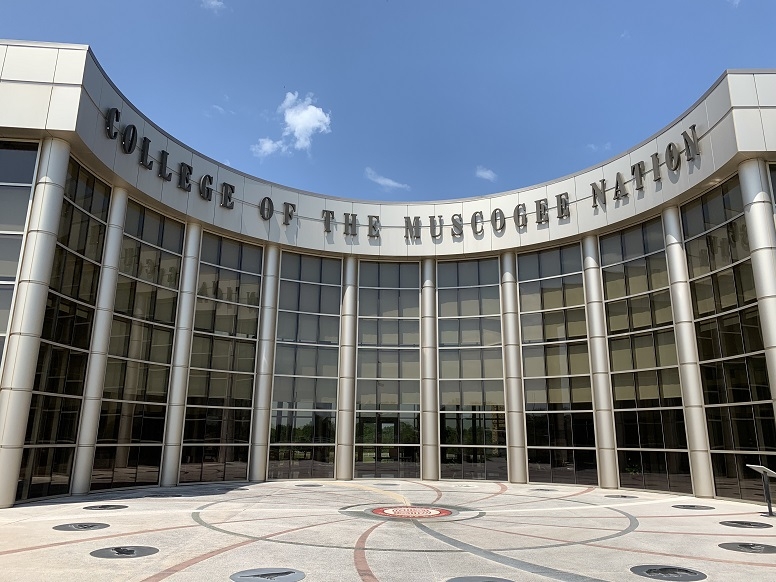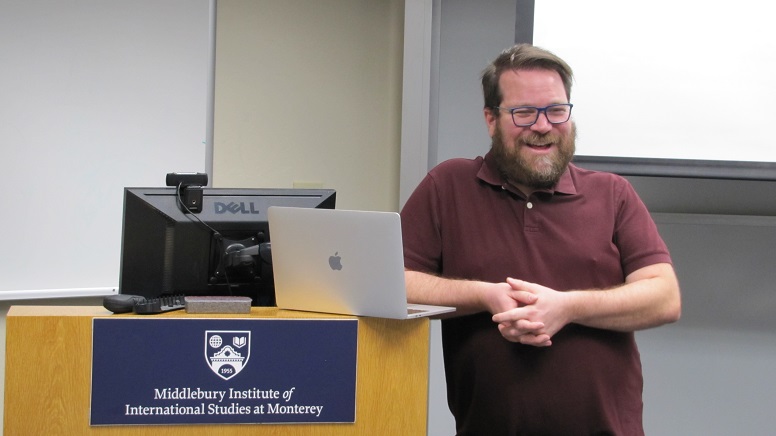Discourse and Repartée 2022 Edition
| by Clara Clymer
Check out the 2022 edition of Discourse and Repartée to learn more about how TESOL and Teaching Foreign Language students, alumni, and faculty are inspiring action and catalyzing change.

The TESOL and Teaching Foreign Language program chair spent four days working with language teachers on the campus of the tribal college in Okmulgee, Oklahoma.
These consulting workshops are part of the teacher training arm of the Institute’s language programs, and Martel conducts several each year. “We’re open to offering customized teacher training programs to any institution that needs them,” he said.
The College of the Muscogee Nation (CMN) reached out to the Institute for help with designing curriculum for the college’s Muscogee language courses. The college offers these courses—along with those on such topics as Native American history, tribal government, and Indian land issues—in addition to general education classes.
The Muscogee (Creek) language has long been under threat of extinction due to colonization, and that threat has only grown with COVID-19, which has taken a disproportionate toll on tribal elders, who are generally the most proficient speakers of the language. “My heart goes out so much to the community,” Martel said, “because they’re seeing their language dwindling.”
This issue, Martel said, added a distinct angle to the workshop. “This was a workshop on language pedagogy: designing curricular thematic units, lesson plans, and assessments through the lens of revitalization, through the lens of helping assure that the Muscogee language and culture have a future.”

One of the core elements of the Middlebury Institute’s language programs is content-based instruction. Rather than designing lessons primarily around grammar and vocabulary and then building content around them, instructors focus on course content, with the language lessons growing from the topics they are covering. “It’s not designing a syllabus based on what grammar points I want to cover,” Martel said. “It’s saying, well, what ideas do I want to dabble in, and then what language resources do I need to teach in order to facilitate working with those ideas?”
The ideas of most interest on the CMN campus, not surprisingly, centered on the Muscogee culture. With that in mind, Martel said, workshop participants identified texts that would be useful to base the curriculum on, such as origin stories and Bible stories.
In addition to such texts, Martel emphasized the potential of using the language in contemporary ways. “Part of my recommendation was saying, ‘What new texts can be created in Muscogee, like new media outlets or stuff like that, new ways to engage with the Muscogee culture?’” This is not to ignore the historic importance of the language but to give it added energy today and into the future.
Martel came away from the workshop feeling like he had made some meaningful connections; he has had a follow-up meeting with one of the participants and will be speaking with the president of the college about future engagement, whether formal or informal. He also just had fun. “There were a lot of really good spirits and good humor, and I really appreciated that.”
Language revitalization is an important issue across many cultures, Martel said—listing the Hawaiian, Māori, and Irish languages off the top of his head—and this workshop challenged him to think about how curriculum design can help preserve, and revive, threatened languages. “It gave me a perspective of the struggles that people in this situation are dealing with and see where my work can align with their goals.”
He stressed that it is the people of the Muscogee Nation, not outsiders like him, who are doing the hard work to preserve their culture. “But hopefully,” he said, “this was one small piece to offer to help them keep their language vibrant and growing.”
Jason Martel
TESOL and Teaching Foreign Language
Teacher Training
College of the Muscogee Nation
| by Clara Clymer
Check out the 2022 edition of Discourse and Repartée to learn more about how TESOL and Teaching Foreign Language students, alumni, and faculty are inspiring action and catalyzing change.
| by Emily Cipriani
From surrealist poetry translations to curriculum strategies for language teachers, see what members of the Institute community have recently published.
| by Jason Warburg
In response to significant demand for a remote option, the Middlebury Institute recently launched a new online Master of Arts in TESOL program that allows students to complete their master’s degrees in two years without having to relocate to Monterey.